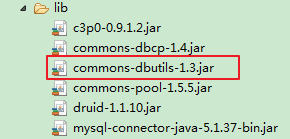commons-dbutils 是 Apache 组织提供的一个开源 JDBC工具类库,封装了针对于数据库的增删改查操作
导入jar包:

1.JDBCUtils
public class JDBCUtils {
/**
* 使用Druid数据库连接池技术
*
* @return
* @throws SQLException
*/
private static DataSource source1;
/**
* 静态代码块,类加载的时候执行
* 把注册驱动程序的代码放在静态代码块中,避免多次获取连接对象时重复调用
*/
static{
try {
Properties pros = new Properties();
InputStream is = ClassLoader.getSystemClassLoader().getResourceAsStream("druid.properties");
pros.load(is);
source1 = DruidDataSourceFactory.createDataSource(pros);
} catch (Exception e) {
e.printStackTrace();
}
}
public static Connection getConnection3() throws SQLException{
Connection conn = source1.getConnection();
return conn;
}
/**
*
* @Description 使用dbutils.jar中提供的DbUtils工具类,实现资源的关闭
*/
public static void closeResource(Connection conn, Statement ps, ResultSet rs){
DbUtils.closeQuietly(conn);
DbUtils.closeQuietly(ps);
DbUtils.closeQuietly(rs);
}
}
2.使用现成的jar中的QueryRunner测试增、删、改的操作:
/**
* 测试插入
*/
@Test
public void testInsert() {
Connection conn = null;
try {
QueryRunner runner = new QueryRunner();
conn = JDBCUtils.getConnection3();
String sql = "insert into customers(name,email,birth) values(?,?,?)";
int insertCount = runner.update(conn, sql, "吴世勋", "wsx@163.com", "1994-07-23");
System.out.println("一共插入了" + insertCount + "条数据");
} catch (SQLException e) {
e.printStackTrace();
} finally {
JDBCUtils.closeResource(conn, null, null);
}
}
3.使用现成的jar中的QueryRunner测试查询,封装表中的一条记录的操作
/**
* 测试查询
* BeanHander:是ResultSetHandler接口的实现类,用于封装表中的一条记录。
*/
@Test
public void testQuery1() {
Connection conn = null;
try {
QueryRunner runner = new QueryRunner();
conn = JDBCUtils.getConnection3();
String sql = "select id,name,email,birth from customers where id = ?";
BeanHandler<Customer> handler = new BeanHandler<Customer>(Customer.class);
Customer customer = runner.query(conn, sql, handler, 22);
System.out.println(customer);
} catch (SQLException e) {
e.printStackTrace();
} finally {
JDBCUtils.closeResource(conn, null, null);
}
}
4.查询,返回表中的多条记录构成的集合
/*
* BeanListHandler:是ResultSetHandler接口的实现类,用于封装表中的多条记录构成的集合。
*/
@Test
public void testQuery2() {
Connection conn = null;
try {
QueryRunner runner = new QueryRunner();
conn = JDBCUtils.getConnection3();
String sql = "select id,name,email,birth from customers where id < ?";
BeanListHandler<Customer> handler = new BeanListHandler<Customer>(Customer.class);
List<Customer> customers = runner.query(conn, sql, handler, 22);
customers.forEach(System.out :: println);
} catch (SQLException e) {
e.printStackTrace();
} finally {
JDBCUtils.closeResource(conn, null, null);
}
}
5.将字段及相应字段的值作为map中的key和value,返回一条记录
/*
* MapHander:是ResultSetHandler接口的实现类,对应表中的一条记录。
* 将字段及相应字段的值作为map中的key和value
*/
@Test
public void testQuery3(){
Connection conn = null;
try {
QueryRunner runner = new QueryRunner();
conn = JDBCUtils.getConnection3();
String sql = "select id,name,email,birth from customers where id = ?";
MapHandler handler = new MapHandler();
Map<String, Object> customer = runner.query(conn, sql, handler, 22);
System.out.println(customer);
} catch (SQLException e) {
e.printStackTrace();
} finally {
JDBCUtils.closeResource(conn, null, null);
}
}
6.MapListHander,返回多条记录
/*
* MapListHander:是ResultSetHandler接口的实现类,对应表中的多条记录。
* 将字段及相应字段的值作为map中的key和value。将这些map添加到List中
*/
@Test
public void testQuery4(){
Connection conn = null;
try {
QueryRunner runner = new QueryRunner();
conn = JDBCUtils.getConnection3();
String sql = "select id,name,email,birth from customers where id <= ? ";
MapListHandler handler = new MapListHandler();
List<Map<String, Object>> list = runner.query(conn, sql, handler, 22);
list.forEach(System.out :: println);
} catch (SQLException e) {
e.printStackTrace();
} finally {
JDBCUtils.closeResource(conn, null, null);
}
}
7.特殊值查询
/*
* ScalarHandler:用于查询特殊值
*/
@Test
public void testQuery5(){
Connection conn = null;
try {
QueryRunner runner = new QueryRunner();
conn = JDBCUtils.getConnection3();
String sql = "select count(*) from customers";
ScalarHandler handler = new ScalarHandler();
Long count = (Long) runner.query(conn, sql, handler);
System.out.println("该表共有" + count + "条数据");
} catch (SQLException e) {
e.printStackTrace();
} finally {
JDBCUtils.closeResource(conn, null, null);
}
}
@Test
public void testQuery6(){
Connection conn = null;
try {
QueryRunner runner = new QueryRunner();
conn = JDBCUtils.getConnection3();
String sql = "select max(birth) from customers";
ScalarHandler handler = new ScalarHandler();
Date birth = (Date) runner.query(conn, sql, handler);
System.out.println("该表最小的人出生日期为:" + birth);
} catch (SQLException e) {
e.printStackTrace();
} finally {
JDBCUtils.closeResource(conn, null, null);
}
}
8.自定义ResultSetHandler的实现类
/*
* 自定义ResultSetHandler的实现类
*/
@Test
public void testQuery7(){
Connection conn = null;
try {
QueryRunner runner = new QueryRunner();
conn = JDBCUtils.getConnection3();
String sql = "select id,name,email,birth from customers where id = ?";
ResultSetHandler<Customer> handler = new ResultSetHandler<Customer>(){
@Override
public Customer handle(ResultSet resultSet) throws SQLException {
// System.out.println("handle");
// return null;
// return new Customer(12, "成龙", "Jacky@126.com", new Date(234324234324L));
if(resultSet.next()){
int id = resultSet.getInt("id");
String name = resultSet.getString("name");
String email = resultSet.getString("email");
Date birth = resultSet.getDate("birth");
Customer cust = new Customer(id,name,email,birth);
return cust;
}
return null;
}
};
Customer customer = runner.query(conn, sql, handler,22);
System.out.println(customer);
} catch (SQLException e) {
e.printStackTrace();
} finally {
JDBCUtils.closeResource(conn, null, null);
}
}










 本文介绍了Apache组织的开源JDBC工具类库commons-dbutils,它封装了数据库增删改查操作。还详细阐述了导入jar包后,使用QueryRunner进行增删改操作、查询单条和多条记录、以map形式返回记录、特殊值查询以及自定义ResultSetHandler实现类等内容。
本文介绍了Apache组织的开源JDBC工具类库commons-dbutils,它封装了数据库增删改查操作。还详细阐述了导入jar包后,使用QueryRunner进行增删改操作、查询单条和多条记录、以map形式返回记录、特殊值查询以及自定义ResultSetHandler实现类等内容。
















 671
671

 被折叠的 条评论
为什么被折叠?
被折叠的 条评论
为什么被折叠?








